Here you can find a brief review of what we are busy with. Below are more details.
Rational Design of Biocompatible Materials Based on Chemically Modified Cellulose
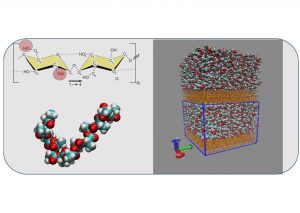 The ultimate goal of this project is the creation and development of a rational design protocol for bionanocomposite materials based on chemically modified cellulose. This involves: i) development of a predictive integrated multiscale simulation protocol for the design of such materials, ii) verifying its foundations against analytical theory and experimental studies, and iii) collaboration with the Institute of Macromolecular Compounds (IMC) of Russian Academy of Sciences (RAS) which implements the computer-aided new design platform. This integrated approach provides a novel, innovative, and scalable platform for optimization and development of biodegradable and biocompatible polymer materials with chemically-modified surfaces, in particular bionanocomposites, for high-tech ecologically safe industrial and biomedical applications.
The ultimate goal of this project is the creation and development of a rational design protocol for bionanocomposite materials based on chemically modified cellulose. This involves: i) development of a predictive integrated multiscale simulation protocol for the design of such materials, ii) verifying its foundations against analytical theory and experimental studies, and iii) collaboration with the Institute of Macromolecular Compounds (IMC) of Russian Academy of Sciences (RAS) which implements the computer-aided new design platform. This integrated approach provides a novel, innovative, and scalable platform for optimization and development of biodegradable and biocompatible polymer materials with chemically-modified surfaces, in particular bionanocomposites, for high-tech ecologically safe industrial and biomedical applications.
Going Glassy: Revealing Structure and Dynamics of Glassy Polymer Films
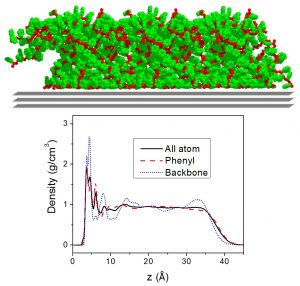
The confinement effects on both structural and dynamical aspects of polymer glasses are tremendous when the confinement size is comparable to the chain dimensions. We simulate, also under the shear deformation (movie), the film thickness dependence of the average glass transition temperature in very thin (few nm !) polymer films. We try to understand the effect of confinement on the structure, segmental mobility and mechanical properties of different polymers and nanocomposites. We map the nanoscale simulated polymer dynamics to experiments which use cyclic (on the scale of seconds!) shear deformation. Here is another YouTube movie for you! And here is the link to the J. Chem. Phys. special issue on thin polymer films with our contribution.
Predicting Morphologies of Solar Cells
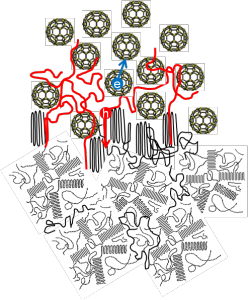 We contribute to a fully predictive multiphysics computational approach to the functioning of Organic Photovoltaic Cells (OPVC). This requires completing the knowledge about the functioning of OPVCs by obtaining a detailed understanding of the atomic-scale morphology and electronic processes at the Donor-Acceptor interface and linking this to larger scales. An important idea is that, next to the pure polymer and fullerene phases, there is a finely intermixed polymer/fullerene phase – called the mixed phase – that is essential for efficient functioning of the OPVC . It is thought that in this mixed phase polymer chains connected to the polymer crystallites penetrate the fullerene network; see Figure on the left. Excitons created by light in the pure polymer phase diffuse to the mixed phase, where they have a somewhat lower energy, and then separate into free charges. The polymer chains that stick out into the fullerene network are supposed to quickly transfer the holes along their backbone to the crystalline polymer phase, where they delocalize, while the electrons move into the pure fullerene phase by the good electronic contact between the fullerenes. By the unique combination of a morphological and electronic-structure study we are able to create breakthroughs in the understanding of the charge-separation process. Such study is unique in its character and critical in completing the knowledge chain of the functioning of OPVCs. We give answers to the many questions around the ‘hot-exciton’ and ‘mixed-phase’ ideas by providing unbiased explicit calculations.
We contribute to a fully predictive multiphysics computational approach to the functioning of Organic Photovoltaic Cells (OPVC). This requires completing the knowledge about the functioning of OPVCs by obtaining a detailed understanding of the atomic-scale morphology and electronic processes at the Donor-Acceptor interface and linking this to larger scales. An important idea is that, next to the pure polymer and fullerene phases, there is a finely intermixed polymer/fullerene phase – called the mixed phase – that is essential for efficient functioning of the OPVC . It is thought that in this mixed phase polymer chains connected to the polymer crystallites penetrate the fullerene network; see Figure on the left. Excitons created by light in the pure polymer phase diffuse to the mixed phase, where they have a somewhat lower energy, and then separate into free charges. The polymer chains that stick out into the fullerene network are supposed to quickly transfer the holes along their backbone to the crystalline polymer phase, where they delocalize, while the electrons move into the pure fullerene phase by the good electronic contact between the fullerenes. By the unique combination of a morphological and electronic-structure study we are able to create breakthroughs in the understanding of the charge-separation process. Such study is unique in its character and critical in completing the knowledge chain of the functioning of OPVCs. We give answers to the many questions around the ‘hot-exciton’ and ‘mixed-phase’ ideas by providing unbiased explicit calculations.
Ion Permeability in Metal-Free Flow Batteries by Multiphysics Modelling
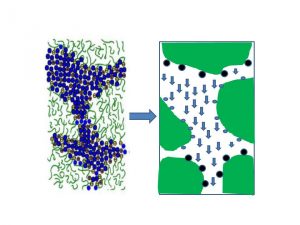 Large scale energy storage is necessary and urgently needed in stable grid management (as load leveling and peak shaving), and for the integration of renewable energy sources. The redox flow battery (FB) provides a unique combination of high efficiency and long cycle life. The key FB components are redox pairs (usually vanadium ions), electrodes and a separating polymer membrane to prevent the electrolytes to cross mix and to transfer ions. High-quality, low-cost materials are vital to achieve large-scale acceptable FBs; ion chemistry and transport are the key factors in determining the final FB performance. We use multiscale simulations to provide fundamental physical insights into the ion transport in novel, metal free, organic-inorganic aqueous FB. Our atomistic non-equilibrium molecular-dynamics simulations deliver polymer/electrolyte/electrode interfaces and local diffusivities for large-scale Lattice-Boltzmann simulations of permeabilities and transport in porous media. Our project may lead to a substantial cost reduction and increased efficiency of FB by advising experiments with improved membranes and optimized electrode geometry.
Large scale energy storage is necessary and urgently needed in stable grid management (as load leveling and peak shaving), and for the integration of renewable energy sources. The redox flow battery (FB) provides a unique combination of high efficiency and long cycle life. The key FB components are redox pairs (usually vanadium ions), electrodes and a separating polymer membrane to prevent the electrolytes to cross mix and to transfer ions. High-quality, low-cost materials are vital to achieve large-scale acceptable FBs; ion chemistry and transport are the key factors in determining the final FB performance. We use multiscale simulations to provide fundamental physical insights into the ion transport in novel, metal free, organic-inorganic aqueous FB. Our atomistic non-equilibrium molecular-dynamics simulations deliver polymer/electrolyte/electrode interfaces and local diffusivities for large-scale Lattice-Boltzmann simulations of permeabilities and transport in porous media. Our project may lead to a substantial cost reduction and increased efficiency of FB by advising experiments with improved membranes and optimized electrode geometry.
Understanding the visco-elasticity of elastomer-based nanocomposites
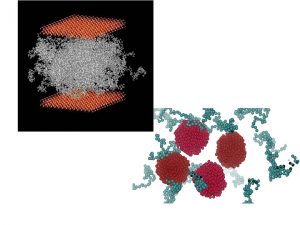 The project aims to study, using computer modelling, the mechanical properties of elastomer-based nanocomposites for the applications in the automotive industry (production of car tires, Michelin) and as sealants (SKF). Usually, in these materials inorganic nanoparticles (Carbon Black, silica), commonly referred to as fillers, are added to rubber in order to increase its rigidity at low strain magnitudes. Nonlinear phenomena restrain the performance of the resulting composites and the development of possible new applications. The goal of the project is to connect the viscoelastic properties of the elastomer-based composites with their microstructure, and the microstructure with the adhesion polymer-filler interactions at the segmental scale. Control of these interactions will lead to the design of new materials with tailored specific mechanical properties. We investigate, using fully-atomistic and coarse-grained molecular-dynamics computer simulations, the equilibrium structure and the dynamics of the composite constituent parts, as well as their mechanical properties under the influence of the oscillatory shear, on different scales.
The project aims to study, using computer modelling, the mechanical properties of elastomer-based nanocomposites for the applications in the automotive industry (production of car tires, Michelin) and as sealants (SKF). Usually, in these materials inorganic nanoparticles (Carbon Black, silica), commonly referred to as fillers, are added to rubber in order to increase its rigidity at low strain magnitudes. Nonlinear phenomena restrain the performance of the resulting composites and the development of possible new applications. The goal of the project is to connect the viscoelastic properties of the elastomer-based composites with their microstructure, and the microstructure with the adhesion polymer-filler interactions at the segmental scale. Control of these interactions will lead to the design of new materials with tailored specific mechanical properties. We investigate, using fully-atomistic and coarse-grained molecular-dynamics computer simulations, the equilibrium structure and the dynamics of the composite constituent parts, as well as their mechanical properties under the influence of the oscillatory shear, on different scales.
(Nearest) Future Plans
- coacervates
- polymersomes
- materials for 3D printing
